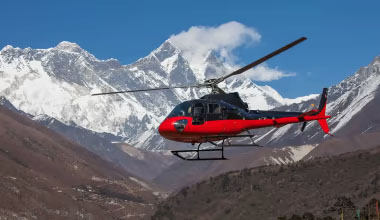Mount Everest, the highest peak in the world, has always been a dream destination for adventurers and mountaineers. The trek to Everest Base Camp is a challenging and strenuous journey, often requiring weeks of preparation and acclimatization. However, with the advent of helicopter tourism, reaching this iconic destination has become more accessible to everyone, regardless of their physical fitness or time constraints. This blog explores how helicopter tourism is revolutionizing travel to Everest Base Camp and what you can expect from this exhilarating experience.
The Evolution of Helicopter Tourism
Helicopter tourism in Nepal has grown significantly in recent years, offering a convenient and thrilling way to explore the breathtaking landscapes of the Himalayas. With modern helicopters equipped with advanced safety features and experienced pilots at the helm, visitors can now enjoy a safe and comfortable journey to Everest Base Camp. This mode of travel is especially beneficial for those who may not have the physical capability to undertake the strenuous trek or those with limited time.
The Journey to Everest Base Camp by Helicopter
Departure and Scenic Flight
The adventure begins with a departure from Kathmandu, the capital city of Nepal. As the helicopter ascends, passengers are treated to panoramic views of the lush green valleys, terraced fields, and traditional villages. The flight offers a bird’s-eye view of the stunning Himalayan range, including glimpses of other iconic peaks such as Lhotse, Nuptse, and Ama Dablam.
Landing at Lukla
The first stop is usually Lukla, a small town with one of the most challenging airstrips in the world. After a brief stop to refuel and acclimate, the journey continues, with the landscape gradually changing from verdant forests to rugged, snow-covered terrains.
Kala Patthar: The Highlight of the Trip
One of the main highlights of the helicopter tour is a landing at Kala Patthar, a viewpoint situated at an altitude of 5,545 meters. From here, visitors get an unparalleled close-up view of Mount Everest and the surrounding peaks. The sight of the majestic Everest towering over the horizon is a moment of awe and wonder, making it a perfect spot for photography and contemplation.
Everest Base Camp
The helicopter then makes its way to Everest Base Camp, located at an altitude of 5,364 meters. Landing at the base camp, visitors can experience the unique atmosphere of the starting point for many Everest expeditions. Here, you can walk around the base camp, take in the breathtaking scenery, and immerse yourself in the spirit of adventure that permeates the area.
Return Journey
After spending some time at Everest Base Camp, the helicopter begins its descent back to Kathmandu. The return journey offers another chance to soak in the magnificent Himalayan vistas, ensuring that the adventure ends on a high note.
Advantages of Helicopter Tourism to Everest Base Camp
Accessibility
Helicopter tourism opens up Everest Base Camp to a wider audience, including those who may not be physically capable of enduring the challenging trek. It provides an opportunity for elderly travellers, families with young children, and individuals with disabilities to experience the grandeur of Everest.
Time Efficiency
For travellers with limited time, a helicopter tour is a perfect option. What would typically take weeks of trekking can now be accomplished in a single day, allowing more flexibility in travel plans.
Safety and Comfort
Modern helicopters are equipped with the latest safety features and are piloted by experienced professionals. The journey is designed to ensure maximum comfort and safety, making it a viable option for travellers who prioritize convenience.
Practical Tips for a Helicopter Tour to Everest Base Camp
- Book in Advance: Helicopter tours are popular and can get booked up quickly, especially during peak seasons. It’s advisable to book your tour well in advance.
- Dress Appropriately: The temperature at high altitudes can be extremely cold. Wear layered clothing, a warm jacket, gloves, and a hat.
- Stay Hydrated: Even though the journey is relatively short, the altitude can cause dehydration. Drink plenty of water before and during the trip.
- Follow Instructions: Listen to the safety briefing and follow all instructions given by the pilot and guides to ensure a safe and enjoyable experience.


